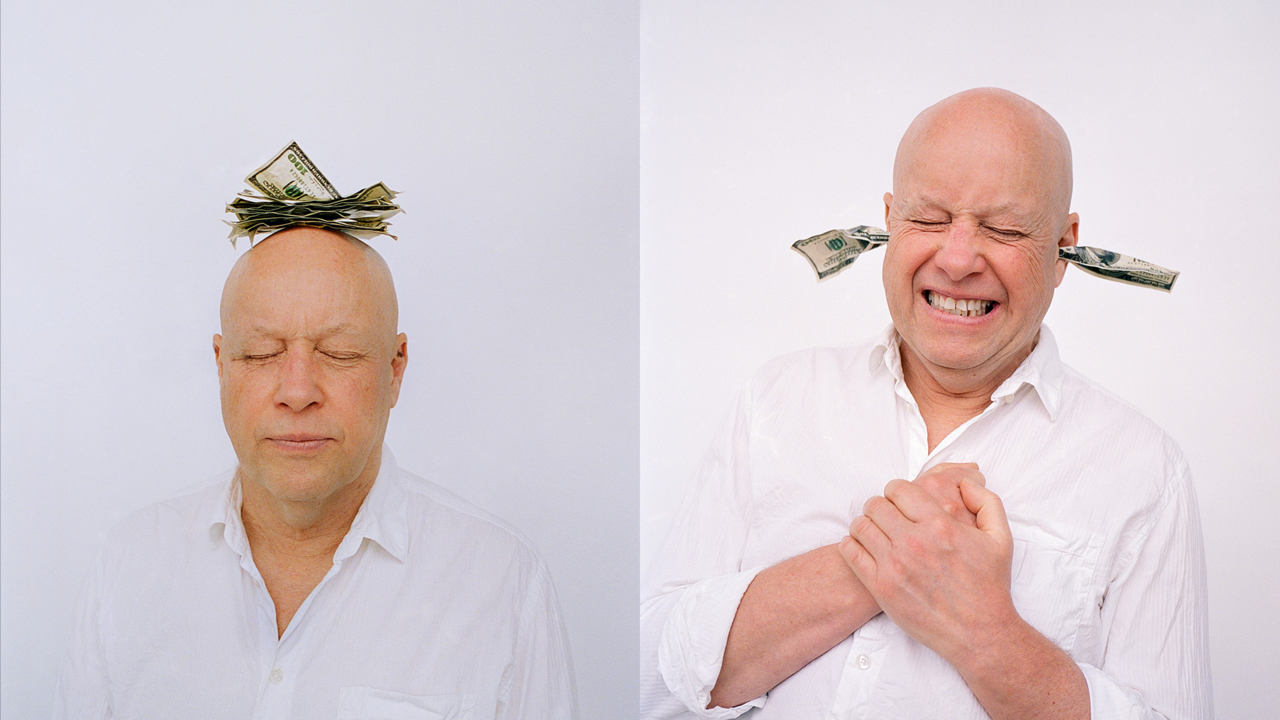Playfully exploring the blurry line between conceptual artist and con man, Take the Money and Run chronicles the bizarre true story of a Danish prankster who effectively stole his own artwork, landing him with a headline-grabbing court case that left him facing financial bankruptcy and reputational ruin. Not to be confused with the screwball Woody Allen comedy of the same name, Ole Juncker’s fast-paced, style-hopping documentary feels at time like a real-life cousin of Ruben Östland’s prize-winning contemporary art-world satire The Square (2017), though it moves beyond scathing take-downs of obvious targets to touch on darker themes, notably issues of mental health and economic insecurity in the lower echelons of the art market. There are serious questions at play here, even if Juncker only skims across them at a breathless gallop.
Produced by the Danish broadcaster DR, Take the Money and Run is enjoying its German premiere at DOK Leipzig this week following an acclaimed festival run at CPH: DOX, Tribeca and others. Its zippy blend of close-up reportage with brief animated segments feel like a good match for the long-running East German event, where documentary and animation are the two main areas of focus. More festivals are likely to book this highly entertaining yarn, which also has solid credentials for big or small screen sales with its marketable mix of charismatic anti-hero, twist-heavy story and slick production values.
In 2021, the Kunsten modern art gallery in the northern Danish city of Aalborg commissioned Jens Haaning to recreate two of his earlier works for an exhibition, conceptual pieces which placed real money inside picture frames, bluntly literal illustrations of average wages in Denmark and Austria respectively. The museum lent the artist 532,000 Danish krone (roughly equivalent to 74,000 Euros, or 85,000 US dollars) for the purpose, but instead of completing the agreed works he pocketed the cash and delivered two blank frames under the title Take the Money and Run. It was part stealth heist, and part audacious performance art statement.
The museum displayed the works anyway, but when Haaning refused to return the money, they launched a civil lawsuit against him which became an international news story. Juncker’s cameras follow this colourful public battle, with the artist making audacious claims in interviews, insisting he cannot repay the money because breaching his contract was the whole point of the artwork. He then launches a counter-suit against the gallery bosses, claiming they actually owe him millions for selling images of his work to global media outlets. News pundits seize on the story, with some applauding Haaning as a Banksy-style provocateur exposing the greed and stupidity of the art world, while others attack him as a common thief.
Pseudo-shocking films which excoriate the contemporary art scene as a pretentious, money-driven sham feel pretty tired nowadays, but Juncker correctly surmises there is more to this case than mere commerce. Digging into Haaning’s back story, he finds bipolar depression stretching back to childhood, a key driver of his extreme mood swings and impulsive, self-destructive behaviour. “My whole life has been one long bad decision,” he jokes in a lucid moment between crushing slumps and manic episodes.
That said, the default tone of Take the Money and Run is comic, largely because Haaning is such an amusingly articulate, mischievous, loose-cannon protagonist. Despite mounting debts and legal battles, he continues to spend money he does not have on madcap schemes. Fleeing Copenhagen for the tranquil Danish island of Møn, he attempts to buy a disused village post office for his new studio headquarters, desperately begging his bank for a bridging loan, then jetting off to Europe in a crazed bid to raise some fast cash. “I have headache,” his hilariously deadpan Romanian curator scowls after their fruitless discussion. “This is not happy meeting.”
Take the Money and Run feels oddly anticlimactic in its final act. Juncker covers the court case with minimal drama, condensing it into a few terse phone calls and quickfire media reactions. The verdict sends Haaning into a deep depression compounded by looming financial disaster. But without getting into too many spoilers, a compromise deal allows him, and the film, a happy ending of sorts.
This mental heath subplot deserves deeper exploration, just as Haaning’s ever-changing “explanations” of his artistic intentions would have benefited from more investigative rigour. But Juncker seems a little too eager to squeeze a messy, contradictory, psychologically complex story into a neat narrative. To this end, his use of heart-tugging piano music becomes jarringly heavy-handed at times. That said, his deft command of rapid-fire visual collage, percussive jump cuts and brief animated sections undeniably make for a punchy stylistic package overall, a persuasive aesthetic mirror of his subject’s scrambled mental state.
Director, cinematography: Ole Juncker
Editing: Lars Juul
Producers: Bjarte Mørner Tveit, Mette Heide
Music: Francois Rousselot
Animation: Rasmus Brink
Venue: Dok Leipzig Festival (Audience Competition)
Production company, world sales: DR (Denmark)
In Danish, English
82 minutes



